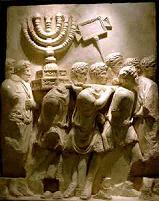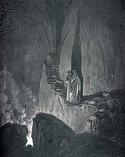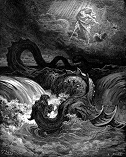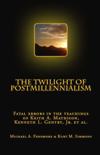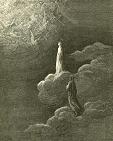 |
The Marriage of the Lamb The marriage of the Lamb is an eschatological theme, tied to the second coming of Christ (Matt. 25: 1-13). What is the significance of this imagery and when was it fulfilled?
Marriage Imagery
in the Old Testament - Covenant with In the Old Testament, the imagery of marriage was a
symbol for the law of Moses and covenant with |
"I remember thee, the
kindness of thy youth, the love of thine espousals, when thou
wentest after me in the wilderness, in a land that was not sown"
(Jer. 2:2).
God "married"
"Now when I passed by thee, and looked upon thee, behold,
thy time was the time of love; and I spread my skirt over thee,
and covered thy nakedness: yea, I sware unto thee and entered
into a covenant with thee, saith the Lord God, and thou becamest
mine" (Ezek. 16:8).
The language of "spreading his skirt" over Israel
(consummating the marriage) should probably be interpreted as
Moses setting up the tabernacle and the "glory cloud" filling it
(Ex. 40:17-38), representing God dwelling with his people and
cohabitating with his bride.
Marriage requires faithfulness in the spouses; adultery
and fornication are causes for divorce.
As
"Wherefore, O harlot,
hear the word of the Lord: Thus saith the Lord God; Because thy
filthiness was poured out, and thy nakedness discovered through
thy whoredoms with thy lovers, and with all the idols of thy
abominations, and by the blood of thy children, which thou did
give unto them: Behold, therefore I will gather all thy lovers,
with whom thou hast taken pleasure, and all them that thou hast
loved, with all them that thou hast hated; I will even gather
them around about against thee, and will discover thy nakedness
unto them, that they may see all thy nakedness And I will judge
thee, as women that break wedlock and shed blood are judged; and
I will give thee blood in fury and jealously" (Ezek. 16:35-38).
Although
"Sing, O barren, thou
that didst not bear; break forth into singing, and cry aloud
thou that didst not travail with child: for more are the
children of the desolate that the children of the married wife,
saith the Lord. Enlarge the place of thy tents, and let them
stretch forth the curtains of thine habitations: spare not,
lengthen thy cords, and strengthen thy stakes; for thou shalt
break forth on the right hand and on the left: and thy see shall
inherit the Gentiles, and make the desolate cities to be
inhabited. Fear not; for thou shalt not be ashamed: neither be
thou confounded; for thou shalt not be put to shame: for thou
shalt forget the shame of thy youth, and shalt not remember the
reproach of thy widowhood any more. For thy Maker is thine
husband; and Lord of host is his name; and thy Redeemer the Holy
One of
This passage, typical of many Old Testament prophecies, looks
beyond the restoration of
Marriage Imagery in the New Testament
John the Baptist was the first to make reference to marriage imagery in the New Testament:
"He that hath the bride
is the bridegroom: but the friend of the bridegroom, which
standeth and heareth him, rejoiceth greatly because of the
bridegroom's voice: this my joy therefore is fulfilled" (Jn.
Christ is the bridegroom; John is his forerunner and friend;
the bride is spiritual
"For they are not all
In terms of chronology, the marriage of Christ to the bride shapes up this way:
·
Death on
· Pentecost thru Second Coming (AD 33-70): Betrothal period; bride washed and purified by the blood of Christ, looking to the consummation.
· Second Coming: Marriage consummated (AD 70); Christ cohabits with wife in the New Jerusalem (church).
Let us survey the scripture where these lessons are found.
Calvary
There are few things clearer than the fact that the Old
Testament legally terminated at the cross. Unbelieving Jews may
have tried to keep the temple ritual and law alive, but there is
no contradicting the fact that Jesus' death on
"Know ye not, brethren,
(for I speak to them that know the law,) how that the law hath
dominion over a man as long as he liveth? For the woman which
hath an husband is bound by the law to her husband so long as he
liveth; but if the husband be dead, she is loosed from the law
of her husband. So then if, while her husband liveth, she be
married to another man, she shall be called an adulteress: but
if her husband be dead, she is free from that law; so that she
is no adulteress, though she be marriage to another man.
Wherefore, my brethren, ye also are become dead to the law by
the body of Christ; that ye should be married to another, even
to him who is raised from the dead, that we should bring forth
fruit unto God" (Rom. 7:14)
This passage teaches us that the law of the first husband
(Old Testament) ended at the death of Christ.
Jesus was national
Pentecost to AD 70: Betrothal Period
During the period from the cross until the second coming, the
church was in a state of "betrothal" or "engagement." Paul
thus says,
"I have espoused you to one husband, that I may present
you as a chaste virgin to Christ" (I Cor. 11:2; cf. Eph.
In Jewish law, the betrothal period was equal in law to marriage and a woman who took another man during this period was just as guilty of adultery as a woman who was in a consummated marriage (Deut. 22:12-21; Matt. 1:18, 19). We sometimes hear it said that the couple lived together during the betrothal period, without consummating the marriage, but the Bible nowhere bears this out. Although betrothed, Joseph and Mary were not living together when she conceived by the Holy Ghost, for she went and lived with her kinswoman, Elizabeth, for three months (Lk.1: 39, 56). When she returned home and it was found that she was pregnant (for she now began to show), the angel instructed Joseph not to fear "to take unto thee Mary thy wife" and "Joseph being raised from sleep did as the angel of the Lord has bidden him, and took unto him his wife" (Matt. 1:23, 24). Thus, although deemed man and wife in contemplation of law during the betrothal period, the husband and wife lived apart. This is confirmed by the parable of the ten virgins, which places the marriage ceremony and consummation at Christ's second coming, after going into a "far country to receive a kingdom and return" (Matt. 25:1-13; Lk. 19:12).
Washed
and Justified from Sin:
Destruction of
There is an error current among Preterists that says the old
law was still valid, and that the church was not justified, but
continued under the debt of sin until AD 70.
Yet, Paul's whole analogy in Rom. 7:1-4 turns upon the
hinge of the Old Testament's end at
Let God be true though every man a liar: The church was not an adulteress, the law had ended, and she was free to take a new husband under the gospel of the risen Savior. What about justification from sin: Would Christ consummate a marriage at his return with a bride soiled with sin? Of course he wouldn't. Thus, the bride was washed and justified during the betrothal so Christ could receive her chaste and pure at his return.
"Husbands, love your
wives, even as Christ loved the church, and gave himself for it;
that he might sanctify and cleanse it with the washing of water
by the word, that the might present it to himself a glorious
church, not having spot, or wrinkle, or any such thing; but that
it should be holy and without blemish" (Eph. 5:25,-27).
Brides are fastidious about their adornment on their wedding
day. Everything must be perfect, "without spot or wrinkle." So,
Christ washed and cleansed his bride from sin at
"Let us be glad and
rejoice, and give honor to him: for the marriage of the Lamb is
come, and his wife hath made herself ready. And to her was
granted that she should be arrayed in fine linen, clean and
white: for the fine linen is the righteousness of the saints"
(Rev. 19:7, 8).
Thus, from AD 33 until the second coming, the church was in a state of purity and sanctification, washed by Christ's blood, waiting to consummate the marriage. She was clothed in fine linen, clean and white, showing that she was justified from sin. There is nothing to the error that the law was valid and the church continued under the debt of sin until AD 70.
AD 70:
The Consummation of Lamb's Marriage with the Bride
The second coming was the point at which the Lord came to dwell with his bride, and cohabit with her, symbolically enjoying the intimacy of sexual union. We see this in Rev. 21:2, 3 where the new Jerusalem comes down to earth:
"And I John saw the holy
city, new Jerusalem, coming down from God out of heaven,
prepared as a bride adorned for her husband. And I heard a great
voice out of heaven saying, Behold, the tabernacle of God is
with men, and he will dwell with them, and they shall be his
people, and God himself shall be with them, and be their God…And
there came one of the seven angels which had the seven vials
full of the seven last plagues, and talked with me, saying, Come
hither, I will shew thee the bride, the Lamb's wife.
And he carried me away in the spirit to a great and high
mountain, and shewed me that great city, the holy
That she is called the "new Jerusalem" shows that she has
replaced the old, earthly
"Thy Maker is thine
husband; the Lord of host is his name…O thou afflicted, tossed
with tempest, and not comforted, behold, I will lay thy stone
with fair colours, and lay thy foundations with sapphires. And I
will make they windows of agates, and thy gates of carbuncles,
and all thy boarders of pleasant stones" (Isa. 54:5, 11, 12; cf
Rev. 21:18-21).
Time of
Fulfillment
Since consummation of the marriage of the Lamb is an important proof that the book of Revelation is fulfilled and the second coming a past event, it is worth pausing to provide proof of its timing.
We have already noted that the term "new Jerusalem" implies
that it replaced "old
"Wherefore, behold, I
send unto you prophets,
and wise men, and scribes: and some of them ye shall kill and
crucify; and some of them shall ye scourge in your synagogues,
and persecute them from city to city: that upon you may come all
the righteous blood upon the earth, from the blood of righteous
Abel unto the blood of Zacharias son of Barachias, whom ye slew
between the temple and altar. Verily I say unto you, All these
things shall come upon this generation" (Matt.
There are many more proofs tying the events described in
Revelation to the time of Nero's persecution and the destruction
of
Conclusion
What was the marriage of the Lamb? The marriage was the point at which the Lord returned from heaven to dwell with his bride, and the church was clothed with the new Jerusalem, the capital city and earthly seat of Christ's throne.
[1] We say "end of Christ's eschatological coming" for it is clear that the coming stretched at least over AD 66-70, the duration of war with Rome, but the marriage occurred only at this period's end.
To receive Kurt Simmons’ e-mail newsletter, The Sword & The Plow, click the Subscribe link:
All rights reserved.
